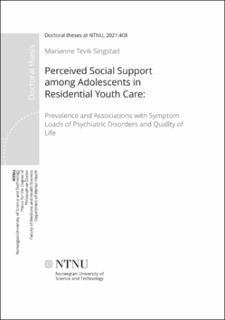| dc.contributor.advisor | Kayed, Nanna Sønnichsen | |
| dc.contributor.advisor | Drugli, May Britt | |
| dc.contributor.advisor | Wallander, Jan Lance | |
| dc.contributor.author | Singstad, Marianne Tevik | |
| dc.date.accessioned | 2022-01-03T13:31:05Z | |
| dc.date.available | 2022-01-03T13:31:05Z | |
| dc.date.issued | 2021 | |
| dc.identifier.isbn | 978-82-326-5858-9 | |
| dc.identifier.issn | 2703-8084 | |
| dc.identifier.uri | https://hdl.handle.net/11250/2835831 | |
| dc.description.abstract | Adolescents living in residential youth care (RYC) often have backgrounds with maltreatment, psychosocial strains, instability in care, and disrupted attachments. Adverse childhood experiences (ACEs) can put these adolescents at high risk of negative development later in life, especially in social relationships. However, a change in environment during adolescence can contribute to positive and healthy development, with new experiences of stability, care, and supportive caregivers. Perceiving social support can be a crucial factor in this regard. The overall aims of this dissertation were to investigate perceived social support among adolescents in Norwegian RYC and to examine social support as a potential moderator between a high number of childhood adversities and subsequent quality of life. More specifically, these issues were investigated through (1) measures of perceived social support, based on the number of support persons listed and individual support providers, as well as social support satisfaction; (2) associations between perceived social support and symptom loads of four psychiatric disorders; and (3) associations between perceived social support and quality of life. The findings from this dissertation will contribute to the aim of best practices in Norwegian RYC, through the investigation of potentially protective factors fostering better mental health and quality of life for adolescents living under public care. This project is part of the larger study “Mental health of children and adolescents in child welfare institutions,” which investigated the background characteristics and history, mental health, the need for, and use of, mental health services, and a variety of other relevant information from 400 adolescents living in Norwegian RYC, comprising 230 girls (mean age = 16.5 years) and 170 boys (mean age = 16.9 years). Of the participants, 78.5% were Norwegian, and 19.7% were 1st- or 2ndgeneration immigrants. All RYC institutions in Norway that met the inclusion criteria were requested to participate. The data were collected from 2010 to 2014. The findings from this dissertation revealed that adolescents in RYC perceived less social support compared with adolescents in the general population. However, they were mainly satisfied with the support they perceived. The most often mentioned support persons were friends (89.8%), mothers (68.4%), and institutional staff (64.5%). Associations between a lower number of support persons and symptoms of emotional disorders were found for both girls and boys. Perceived one-to-one social support was found to be associated with a lower symptom load of emotional disorders for girls (yielding support from institutional staff, friends, and father) and a lower symptom load of behavioral disorders for boys (yielding staff support). Associations were also found between a higher number of support persons and a higher quality of life for boys and between one-to-one social support from friends and institutional staff and a higher quality of life for girls. However, perceived social support did not moderate the negative effects of an increased number of childhood adversities on their quality of life in adolescence. The results emphasize the important role of RYC staff in maintaining adolescents’ social networks when living in RYC. The staff should contribute to the initiation of new, positive social relationships for these vulnerable adolescents while living in RYC and provide stability and care as caregivers. Social networks and supportive relationships are important for the mental health and the quality of life of adolescents in RYC, and institutional staff serve an important role for these purposes. Ensuring the use of other health services for adolescents with the highest numbers of childhood adversities is also crucial, as these adolescents are at high risk of negative development because they are often in need of specialized treatment or help. | en_US |
| dc.language.iso | eng | en_US |
| dc.publisher | NTNU | en_US |
| dc.relation.ispartofseries | Doctoral theses at NTNU;2021:408 | |
| dc.relation.haspart | Paper I: Singstad, M.T., Wallander, J.L., Lydersen, S., Wichstrøm, L., & Kayed, N.S. (2020). Perceived social support among adolescents in Residential Youth Care. Child & Family Social Work. 2020, 25(2), 384-393. https://doi.org/10.1111/cfs.12694 | en_US |
| dc.relation.haspart | Paper II: Singstad, M.T., Wallander, J.L., Lydersen, S., & Kayed, N.S. Perceived social support and symptom loads of psychiatric disorders among adolescents in residential youth care. Social Work Research. (In press). | en_US |
| dc.relation.haspart | Paper III: Singstad, M.T., Wallander, J.L., Greger, H.K., Lydersen, S., & Kayed, N.S. (2021). Perceived social support and quality of life among adolescents in residential youth care: a cross-sectional study. Health and Quality of Life Outcomes. 2021, 19(1), 1-12. https://doi.org/10.1186/s12955-021-01676-1 | en_US |
| dc.title | Perceived Social Support among Adolescents in Residential Youth Care: Prevalence and Associations with Symptom Loads of Psychiatric Disorders and Quality of Life | en_US |
| dc.type | Doctoral thesis | en_US |
| dc.subject.nsi | VDP::Medisinske Fag: 700::Klinisk medisinske fag: 750::Psykiatri, barnepsykiatri: 757 | en_US |
